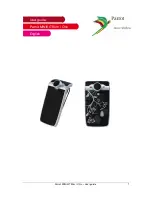
Notes
51
wap-site information in the cache memory to ensure a
fast retrieval of previously visited pages.
Cookies.
WAP-pages may store a small program called a
“cookie” on your phone to monitor your wap-patterns.
Cookies can be disables, but this may exclude you from
entering some wap-sites.
CDMA.
Code Division Multiple Access is a technology
where each phone is allocated a specifi c code and
thereafter shares the available frequencies with other
phones. Widespread in Asia and USA.
Cell Broadcast.
Cell Broadcast is a service from your
network provider. With CB, you will be alerted when
entering a “cheap zone” or you can obtain traffi c
information, weather reports and other important
information sent to you as text messages. Some
providers also offer sports results, news bulletins or
even commercials. If offering CB services, your network
will forward a list of services and the relevant channels
to enter.
CSD.
A wireless service protocol used for WAP. CSD
stands for Circuit Switched Data and will enable
continuous connection and payment by the amount of
data transferred.
DTMF.
Dual Tone Multi Frequency or DTMF is a paging
and remote control protocol that allows you to control
certain functions via your phone, e.g. listening to your
answering machine.
Dual Band.
A dual band mobile phone has the capability
to automatically switch between two frequency bands,
e.g. 900 MHz and 1800 MHz. Triple & quadruple phones
operate on three and four frequencies.
GPRS.
General Packet Radio System is a service
protocol built on GSM technology. GPRS allows several
mobile phone users to share the same connection.
Charges may thus be based on the amount of
transferred data rather than on airtime.
GSM.
Global System for Mobile communications is the
most widespread standard for
digital communication
in
Europe, Australia and in large parts of Asia and Africa.
GSM uses frequencies in the 900 and 1800 MHz bands.
IMEI.
IMEI stands for International Mobile Equipment
Identifi er and is an identifi cation system that can
recognize every mobile phone by a specifi c number. If a
phone is stolen, the IMEI system is capable of blocking
it on all network operators that support the system.
ISP.
ISP stands for Internet Service Provider.
MCC and MNC.
Mobile Country Code is a code that
identifi es the country in which the subscriber lives.
Mobile Network Code identifi es the network operator.
OTA.
Over The Air is a service some network operators
offer which allows settings such as MMS, WAP or E-mail
to be set up automatically.
PIN and PUK.
Access to use a cell phone is most
often protected by a code known as “PIN” - Personal
Identifi cation Number. Your SIM card comes with a
default PIN that you can change to any code you prefer.
If you forget your code, or by mistake enter a faulty
Summary of Contents for FLT E22
Page 65: ...O2 XM FLT E22 Advanced Section ...
Page 70: ...Notes 63 ...
Page 71: ...Notes 64 ...
Page 72: ...Notes 65 ...















































